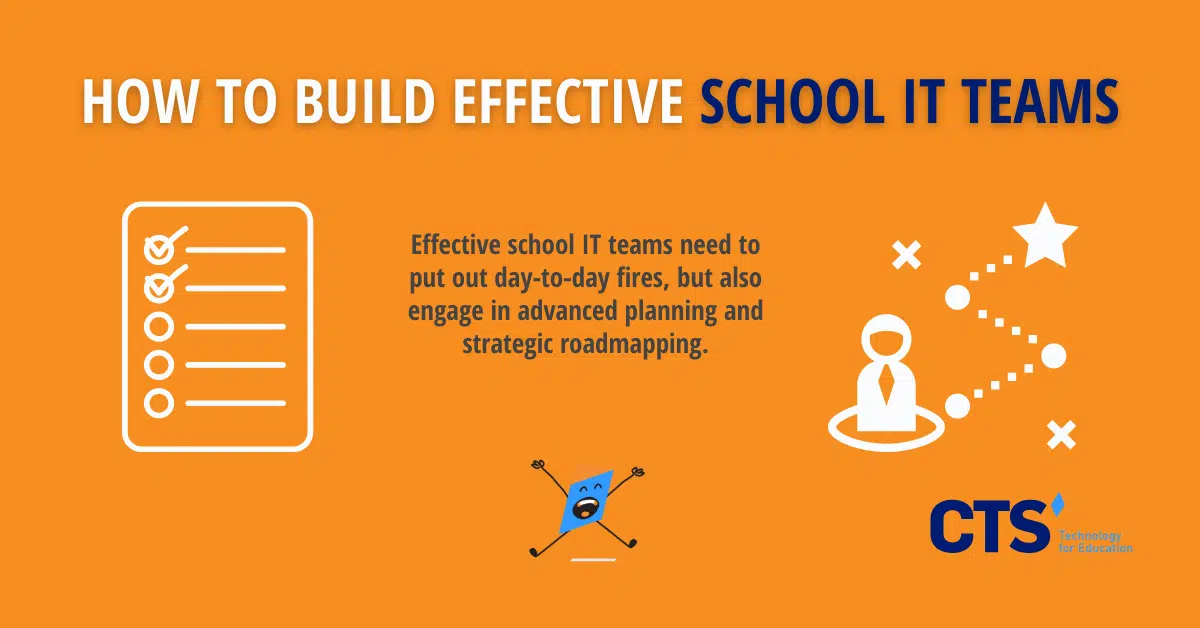School IT teams are more important than ever.
As students transition from remote or hybrid learning to in-person instruction, school IT teams will become more central than ever to daily instruction. During remote learning, Chromebooks, Zoom, Google Classroom, and other online educational platforms became the norm, part of students’ daily routines, and, for many learners, far more effective than traditional instructional methods. When schools resume in-person instruction in the fall, at least some of the benefits of remote learning will likely remain part of regular classroom instruction.
Given these new demands, it’s more important than ever to build effective school IT teams that can comprehensively meet the needs of their school’s educational technology programming. Sure, schools need a team member who can put out the day-to-day fires (e.g., a Chromebook stops working, a teacher can’t remember her password, a projector bulb goes out, etc.), but they’ll also need team members who can think and plan weeks and months in advance. They’ll also need team leadership with a strategic lens to effectively align the school’s instructional priorities with its educational technology programming.
First, school IT teams need to put out the day-to-day fires.
At the very least, schools need a team member who can put out the day-to-day fires that inevitably come with widespread technology use. While many of these issues are the result of user error, others are the result of outdated equipment, improper set-up, or other system-related errors. Whatever the case, schools need a team member who can triage an incoming request, prioritize it alongside their other to-dos, and quickly provide a solution or adequate stopgap measure that allows the teacher or staff member to resume their work.
This role is particularly important for morale: when teachers and school support staff think of their school IT team, they probably picture someone coming in to fix a student’s Chromebook, replace a projector bulb, or help a teacher access an online instructional platform. Having a team member with both strong interpersonal skills and technical know-how can be hard to come by. Still, daily troubleshooting requires both patience and expertise in order to be effective. The team member needs to be able to both diagnose the teacher or staff member’s issue and also explain the solution to them in a way that makes sense to a non-technical audience.
School IT teams must also engage in advanced planning.
Of course, if a school IT team focused exclusively on the day-to-day, it would quickly lose sight of other long-term priorities that demand strong advanced planning skills. End-of-year close-out and beginning-of-year launch are two prime examples of projects that require school IT teams to begin planning months in advance.
For end-of-year close-out, an effective school, IT team will develop a project plan that includes, among other topics, a plan to collect, inventory, and repair student and staff devices, as well as forecast any purchases for the upcoming school year. Effective device collection at the end of the school year can make redeployment at the start of the next year much smoother and ensures that each student and staff member has the hardware they need on day one.
Similarly, a school launch cobbled together at the last minute will almost certainly result in chaos, which in turn will negatively impact the first few weeks of school. Effective school, IT teams know that getting a school launch right is critical to the overall success of the academic year. Having a team member who recognizes the urgency of school launch, close-out, and other long-term priorities to the school’s overall mission is critical for an effective school IT team.
Finally, a school IT team needs to think strategically.
Effective school, IT teams, don’t just keep the trains running at their schools: they also think about how technology programming can add value to the school’s instructional programming. For instance, by taking advantage of the annual E-rate process, effective school IT teams can save their school thousands of dollars each year by outsourcing a project for which they lack the internal capacity and receiving federal reimbursement for a portion of the cost. Similarly, effective school IT teams keep a close eye on the broader educational technology market, cognizant of the sector’s trends and how those trends should or shouldn’t influence the school’s annual purchasing decisions. If a piece of technology is about to become obsolete, it might make sense, for example, to invest in an alternative rather than re-purchasing the existing technology.
At CTS, we help school IT teams accomplish their school’s unique mission.
At CTS, our team has worked with more than 60 schools across the United States to improve their educational technology programming and drive instructional outcomes. Contact us today to learn more about our services and how we can help your school accomplish its unique mission.




